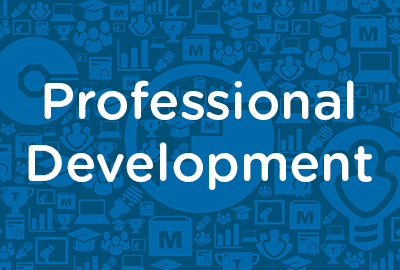 |
Helping Children with ADD Succeed In School-Age Programs: Characteristics and Needs of Children |
1.00 |
Children with ADD regularly experience struggles and challenges at home, in school, and in the community. Without the help of knowledgeable, understanding, and supportive people, they often experience multiple failures and frustrations on a daily basis. In this course, we will explore characteristics and needs of children with ADD. |
 |
Grammar Skills: Punctuation and Mechanics |
1.00 |
This course covers how to punctuate clauses in sentences by using commas, semicolons, colons, and dashes as well as how to set phrases apart by using parentheses and brackets; correctly use apostrophes and hyphens. You will also learn how to use quotation marks and end punctuation; identify when to spell out numbers, money, and dates as well how to correctly capitalize words in sentences. |
 |
Building Relationships with School Personnel |
2.00 |
School-age programs and schools share a mutual goal of supporting the growth, development, and learning of school-age children. Over 50% of all school-age programs nation-wide are housed in school facilities. When school-age programs are housed in school facilities, it is essential for staff in school-age programs to establish and maintain a positive relationship with school personnel. This makes it possible for schools and programs to work together to support the needs of the whole child. Staff can develop successful partnerships with school personnel by cultivating an understanding of the needs, interests, and goals of school personnel and using effective strategies, tools, and systems to build a spirit of positive collaboration and communication. |
 |
Becoming Tech Savvy |
1.50 |
This course was designed to help you learn various tips and tricks to use your devices as efficiently as possible. This includes tech skills, safety & security information, and keyboard and mouse shortcuts. |
 |
Collaboration with Team Members for Paraprofessionals |
1.00 |
This course covers collaboration with team members for paraprofessionals. You will learn what collaboration looks like in the school setting and what it means to use effective collaboration strategies. This course will also dive into what it means to be an effective communicator in the professional setting. |
 |
Connection Planning in Long-Term Care |
1.00 |
This module includes training for staff and providers in the importance of social connection and practical strategies learners can use to promote social connectedness in long-term care. The module explains how to implement Connection Planning, a brief, person-centered behavioral intervention for developing resident care plans that address social connection. Connection Planning includes evidence-informed, practical strategies to promote meaningful social connection among residents in long-term care. |
 |
Interviewing Skills: Handling and Conducting (Instructor Guide) |
1.00 |
Some interviewees demand a particularly focused and skillful use of interviewing techniques. Your ability to handle talkative, uncommunicative, nervous, or inexperienced candidates is important in order to get an accurate assessment of the candidate’s abilities. If you develop ways of handling various types of interviewees before the interview begins, you’ll be able to encourage them to respond positively and share information. You’ll also avoid the mistake of eliminating candidates on the basis of value judgments or preconceptions.
An interview is a two-way conversation designed to gather information about, and provide information to the candidate, so you both can decide on the fit between the position, the organization, and the candidate. Good interviews flow smoothly when both the interviewer and the candidate take part in an information exchange.
In this course you will learn to: handle an interview by developing an understanding of the various types of candidates, and conduct an interview by following a specific structure and using effective communication techniques.
This Instructor's Edition of this course includes notes and suggestions to assist you in presenting the material, whether in an in-person classroom setting, or as an instructor-led online or distance-learning course. It also provides you with the answers to questions found in mid-lesson activities, as well as in the quiz that concludes the course. |
 |
Advanced Interpersonal Communication: Supervisors |
0.75 |
When you think of a supervisor, you probably think of your immediate boss. However, in the workplace, most people have several supervisors. Your workplace might be divided into teams, departments or divisions. Within each level, there is a supervisor to whom you are accountable, even if you do not deal with that person on a day-to-day basis. Company executives and board members can also be considered supervisors because they might have the power to make decisions regarding your employment, salary, promotions, and work assignments. It is important to communicate effectively with all of your supervisors to maintain an efficient workplace and to be able to promote your own ideas for improvements.
In this course you will learn to: identify the types of ineffective supervisors and ways to interact with them, and negotiate a raise with a supervisor and offer an effective resignation. |
 |
Providing Homework Support: Types of Homework Support |
1.00 |
Research indicates there are many different ways to provide effective homework support in school-age programs. When planning a homework support program, it is important for school-age programs to develop a homework philosophy that is consistent with the program’s overall philosophy, and reflects current research on best practices for providing homework help. The homework philosophy should also reflect the needs of parents and children in the program, and strike a balance between homework needs and other experiences that help children grow and learn out-of-school. In this course, we will explore the various types of homework support. |
 |
Mental Health First Aid in the Classroom |
1.00 |
A student shouts in rage, “I wish I were dead!” Is he expressing suicidal ideation? A student quickly covers cut marks over her left forearm. Should we approach her or respect her privacy?
The National Alliance on Mental Illness data show that one in five adolescents between the ages of 13 and 18 will experience a severe mental illness, and only 20 percent will receive treatment. We know, then, that our students are coming to us with mental health needs that are greater than ever before. This can feel overwhelming, especially when we want to help our students achieve to their fullest potential and are not sure how to.
The good news is that basic mental health first aid can offer practical, valuable tools. We don’t need to be a cardiac surgeon to perform CPR, and sometimes CPR can save a life. Similarly, we don’t have to be a licensed mental health professional to provide basic mental health first aid in the classroom.
|
 |
Change Management: Obstacles to Change |
0.75 |
This course will cover how to identify the causes of resistance and the negative reactions to change and the methods for managing them. You will also learn how to identify the causes of complacency and prepare for crisis. |
 |
Microsoft PowerPoint - Basic: Getting Started |
0.75 |
This course will focus on how to open a presentation, identify PowerPoint interface components, switch between views, and zoom in and out. |
 |
Strategy Tactic Task #1431a (Instructor Guide) |
1.00 |
This is the Instructor Guide for Lesson #1431a Strategy Tactic Task. This instructor guide provides the instructor with lesson background, key points, and delivery methods. Required lesson materials including lesson plan, presentation, and evaluation quiz with answer key. Included in this guide is an explanation video of the presentation that describes each slide of the lesson. |
 |
Asbestos Safety Awareness |
1.00 |
This course covers general information regarding asbestos, such as what it is and where it is found. The associated health hazards and the ways to protect yourself and co-workers against asbestos hazards are also discussed in this course. This course will also teach you how to analyze and discuss case studies regarding asbestos. |
 |
Sales Management: Motivating Sales Teams |
1.00 |
This course will focus on motivating sales professionals, monitoring and increasing motivation levels, and addressing substandard sales performance. |
 |
Advanced Interpersonal Communication: Organizational Culture |
1.34 |
An organizational culture is the personality of an organization. This personality is both determined and accepted by the organization’s members. For example, an organization might have a culture that is youthful, energetic, and fast-paced. In this type of culture, decisions are made quickly, and employees are empowered to take action in a wide variety of situations. Another organization might be more straight-laced and policy-oriented. This organization would be much more formal and serious in the way it does business. It is important to recognize and understand the culture of an organization, so that you can determine your fit with the organization.
In this course you will learn: to determine the nature of an organization’s culture, to use the cultural network to your advantage, and identify the characteristics of the roles exhibited in the network, to identify the elements of physical culture that affect interpersonal communication, and to identify the ways in which managers can build a positive culture. |
 |
Diversity, Equity, and Inclusion Training (Corrections) |
1.00 |
Diversity, Equity and Inclusion have become an important part of creating a culture that thrives on leveraging differences.
The goal is to learn:
Definitions of Diversity, Equity, and Inclusion
Why Diversity, Equity, and Inclusion is Important to Everyone?
Our Identity and Where it Comes From
Bias and The Impact to Others
Next Steps to Take |
 |
GED: Social Studies - Unit 5: Post-Test |
0.25 |
Welcome to Unit 5: Post-Test. This post-test covers civics and government, US history, economics, and world geography. At the end of this post-test is a table that matches each test question to the content it covers. Use it to review and content you haven't mastered. |
 |
Correcting Performance Problems: Disciplining Employees (Instructor Guide) |
1.67 |
Discipline is proactive, as opposed to punishment, which is reactive. Punishment provides a consequence to an action that is deemed unacceptable, whereas discipline is designed to exchange undesirable behavior for satisfactory behavior.
The purpose of disciplining an employee is twofold:
1. To correct or eliminate undesirable behavior, and
2. To provide training that improves or strengthens performance.
In this course you will learn to: keep a disciplinary perspective, determine the cause for disciplining an employee, and prepare for conducting a disciplinary meeting, maintain a positive rapport, avoid pitfalls during a disciplinary meeting with employees, and keep meetings productive, and monitor employee performance and conduct a follow-up meeting with the employee.
This Instructor's Edition of this course includes notes and suggestions to assist you in presenting the material, whether in an in-person classroom setting, or as an instructor-led online or distance-learning course. It also provides you with the answers to questions found in mid-lesson activities, as well as in the quiz that concludes the course. |
 |
Searching Online |
0.75 |
This course covers the fundamentals of searching online. From using basic features, such as the homepage and address bar, to using "advanced search" to find very specific information, this course will cover it all. |
 |
Cultural Competence for Paraprofessionals |
0.75 |
Culture and cultural elements are essential components of people's identities. Understanding the cultural elements as paraprofessionals allows for a greater appreciation for students and can improve relationships. Cultural elements may include race and ethnicity, gender, and socio-economic status. These elements of culture are not separate from the larger cultural context in which we live and work, especially as paraprofessionals. It is important to recognize that many culturally and linguistically diverse families have specific customs and traditions that may not necessarily be connected to a particular cultural group. By understanding cultural competence, paraprofessionals can provide responsive instruction and support to students from all backgrounds. |
 |
Making Your Home A Safer Place |
0.75 |
This course covers household safety. This includes fire and kitchen safety, emergencies, infant safety, and more. This course will help you learn about the best practices for everyone inside the house, from infants to pets. It is just one of the many health and safety courses we offer. |
 |
Sales Management: Forecasting Sales Revenue |
0.50 |
This course will focus on identifying sales forecast factors and types of sales forecasts as well as discussing various types of forecasting approaches. |
 |
Food Allergy Basics in Early Childhood (CDA 1 and 5) |
3.00 |
Welcome to Food Allergy Basics in Early Childhood. This course is focused on ways to prevent accidental exposure to foods that can cause an allergic reaction. You will be able to describe ways to prevent accidental exposure to foods that cause an allergic reaction. You will also be able to demonstrate how to read a food label to reduce the risk of accidental exposure to foods that can cause an allergic reaction. In addition, you will learn how to use a Food Allergy and Anaphylaxis Emergency Care Plan to care for a child with a food allergy and identify the symptoms and triggers of food allergies. This course is also designed to be part of a Child Development Associate (CDA) Credential™ curriculum. It covers Subject Area 1: Planning a Safe, Healthy Environment to Invite Learning and Subject Area 5: Managing an Effective Program Operation. |
 |
Fundamental Tools to Monitor Child Development (CDA 7) |
2.00 |
This course immerses early care and education professionals in the powerful trio of observation, documentation, and assessment. Discover how these tools allow you to closely monitor each child's progress, identify individual needs and interests, and tailor support accordingly. Dive deeper into using assessment activities to refine and elevate the quality of preschool care, ensuring every child reaches their full potential. |


























